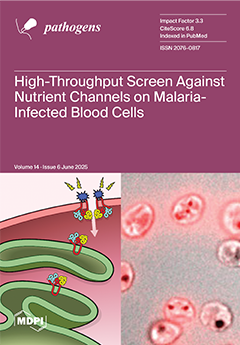Lyssaviruses are RNA viruses in the Family Rhabdoviridae, Genus
Lyssavirus. They represent the causative agents of acute, progressive encephalitis, known historically as rabies. Regardless of specific etiology, their collective viral morphology, biochemistry, pathobiology, associated clinical signs, diagnosis, epizootiology, and management are essentially
[...] Read more.
Lyssaviruses are RNA viruses in the Family Rhabdoviridae, Genus
Lyssavirus. They represent the causative agents of acute, progressive encephalitis, known historically as rabies. Regardless of specific etiology, their collective viral morphology, biochemistry, pathobiology, associated clinical signs, diagnosis, epizootiology, and management are essentially the same. Despite centuries of clinical recognition, these quintessential neurotropic agents remain significant pathogens today, with substantive consequences to agriculture, public health, and conservation biology. Notably, the singular morbidity caused by lyssaviruses is incurable and constitutes the highest case fatality of any viral disease. All warm-blooded vertebrates are believed to be susceptible. The dog is the only domestic animal that serves as a reservoir, vector, and victim. In contrast, felids are effective vectors, but not reservoirs. All other rabid domestic species, such as livestock, constitute spillover infections, as a bellwether to local lyssavirus activity. Frequently, professional confusion abounds among the veterinary community, because although the viral species
Lyssavirus rabies is inarguably the best-known representative in the Genus, at least 20 other recognized or putative members of this monophyletic group are known. Frequently, this is simply overlooked. Moreover, often the ‘taxonomic etiology’ (i.e., ‘
Lyssavirus x’) is mistakenly referenced in a biopolitcal context, instead of the obvious clinical illness (i.e., ‘rabies’). Global consternation persists, if localities believe they are ‘disease-free’, when documented lyssaviruses circulate or laboratory-based surveillance is inadequate to support such claims. Understandably, professional chagrin develops when individuals mistake the epidemiological terminology of control, prevention, elimination, etc. Management is not simple, given that the only licensed veterinary and human vaccines are against rabies virus, sensu lato. There are no adequate antiviral drugs for any lyssaviruses or cross-reactive biologics developed against more distantly related viral members. While representative taxa among the mammalian Orders Chiroptera, Carnivora, and Primates exemplify the major global reservoirs, which mammalian species are responsible for the perpetuation of other lyssaviruses remains a seemingly academic curiosity. This zoonosis is neglected. Clearly, with such underlying characteristics as a fundamental ‘disease of nature’, rabies, unlike smallpox and rinderpest, is not a candidate for eradication. With the worldwide zeal to drive human fatalities from canine rabies viruses to zero by the rapidly approaching year 2030, enhanced surveillance and greater introspection of the poorly appreciated burden posed by rabies virus and diverse other lyssaviruses may manifest as an epidemiological luxury to the overall global program of the future.
Full article






